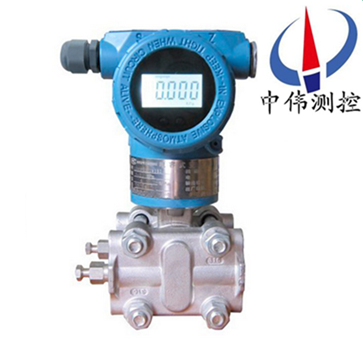Capacitive Negative Pressure Transmitter
I. Product Overview:
The ZW1151SP series capacitive negative pressure transmitter applies digital technology, which not only ensures the high reliability and other superior performance of the instrument, but also realizes the real-time self-checking configuration operation of intelligent instrument and the remote digital connection between the control room and the control room, and realizes the remote inquiry or real-time configuration of the unit instrument in the control room. High accuracy and good stability. Range, zero external adjustable. Miniaturization, light weight, strong vibration resistance. No mechanical moving parts, reliable operation, easy maintenance. Solid element, plug-in printed circuit board. Explosion-proof structure, can be used all day.
II. Working Principle:
ZW 151SP series capacitive negative pressure transmitter is that two kinds of pressure of measured medium enter into high and low pressure chambers, and act on the isolation diaphragm of the two sides of the delta element (i.e. the sensitive element), which is transmitted to both sides of the measuring diaphragm through the isolator and the filling liquid in the element. A capacitor is formed by measuring the diaphragm and the electrodes on both sides of the insulating sheet. When the pressure on both sides is inconsistent, the displacement of the diaphragm is proportional to the pressure difference, so the capacitance on both sides is different, and the signal is converted into a signal proportional to the pressure through oscillation and demodulation.
3. Application occasions:
ZW1151SP series capacitive negative pressure transmitter is mainly used to measure the pressure, negative pressure and absolute pressure of gas, liquid and steam, and then convert it into 4-20 mA.DC signal output. High-precision pressure transmitter can communicate with each other through HART protocol-compliant hand-operated devices. It can measure the pressure of exhaust system, distillation tower, evaporator and crystallizer.
Fourth, main characteristics:
1. Super measurement performance for pressure, differential pressure, liquid level and flow measurement;
2. Digital accuracy: +(-) 0.05%;
3. Stability: 0.25% for 60 months;
4. Range ratio: 100:1;
5. Measurement rate: 0.2S;
6. Miniaturized (2.4kg) stainless steel flange, easy to install;
7. Process connection is compatible with other products to realize measurement.
8. The only sensor in the world that uses H-alloy sheath (technology) achieves excellent cold and thermal stability.
9. Using 16-bit computer;
10. Standard 4-20mA, with HART-based digital signal, remote control supports upgrading to fieldbus and field control technology.
Technical parameters:
1. Targets: liquids, gases and vapors;
2. Measurement range: 0-40 Mpa;
3. Output signal: 4-20mA DC (special for four-wire system); 220V AC power supply, 0-10mA DC output;
4. Power supply: 12-45V DC, generally 24V DC;
5. Load characteristics: related to power supply, with load capacity at a certain power supply voltage; the relationship between load impedance RL and power supply voltage Vs is: RL < 50 (Vs-12);
6. Indicator table: pointer linear indicator 0-100% calibration and LCD liquid crystal display;
7. Explosion-proof grade: a: Exd II BT5 or Exd II CT6; b: intrinsically safe type (Exia II CT6 or Ex IB II CT6).
6. Fault diagnosis:
In the process of measurement, some faults often occur in the transmitter. The timely determination, analysis and treatment of the faults are very important for the ongoing production. Based on the experience of daily maintenance, we summarized some decision analysis methods and analysis processes.
1. Investigation method:
The fire, smoke, odor, power supply change, lightning strike, dampness, misoperation and mismaintenance before the fault occurs are reviewed.
2. Visual method:
Observe the external damage of the circuit, leakage of the pressure guide pipe, overheating of the circuit and the state of the power supply switch.
3. Detection method.
A. Circuit Breaking Detection: Separate the suspected faulty part from other parts to check whether the fault disappears or not. If it disappears, then determine the fault location. Otherwise, the next step can be found. For example, the intelligent differential pressure transmitter can not communicate normally with Hart remote, and the power supply can be disconnected from the instrument body. The transmitter can communicate by adding additional power to the scene to check whether it is or not. Whether the cable superimposes electromagnetic signals of about 2 kHz to interfere with communication.
B. Short Circuit Detection: In the case of ensuring safety, the relevant part of the circuit is directly shortened, such as: the output value of the differential transmitter is too small, the pressure guide pipe can be disconnected, and the differential pressure signal can be directly directed to the two sides of the differential pressure transmitter from the outside of the pressure take-off valve, and the output of the transmitter can be observed to judge the connectivity of the blockage and leakage of the pressure guide pipe.
C. Replacement detection: replace the parts suspected of failure and judge the fault location. For example: suspected transducer circuit board failure, can temporarily replace a piece to determine the cause.
D. Partial detection: divide the measuring circuit into several parts, such as power supply, signal output, signal transmission and signal detection. Check by part, from simple to complex, from table to inside, narrow the scope and find out the fault location.
7. Installation requirements:
1. Before installation, please read the product instructions carefully and check the relevant information of the product.
2. Transmitters should be installed in ventilated, dry, non-corrosive and shady places. If installed in the open air, protective shields should be added to avoid sunshine and rain, and to avoid performance degradation or failure of transducers.
3. Transmitter is a precise instrument. When installed, avoid strong impact and smash.
4. Connect correctly according to wiring diagram.
5. Attention should be paid to protecting the lead-out cable of the transmitter. It is suggested to use metal pipe to protect or overhead when using in industrial field. Do not loosen the sealing nut of the cable lead-out end to avoid moisture entering.



